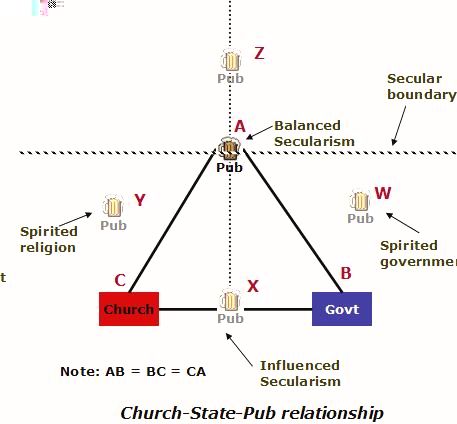Sunday Levity: Between Church and State
You already know that international relations can be best described as a clash over alcohol, a theory that may be described as spiritual realism.
But you probably didn’t know that between the church (or temple or mosque or whatever place it is that they worship FSM) and the state lies an institution called the public house. The extent of secularism in a society has been measured by the distance between the church and the state. But that’s not good enough. The relative distances between these institutions provides a better gauge of the extent of secularism. Because this not only considers separation of religion from government, but also provides an indication of how tolerant the society actually is.

What about a society of consisting entirely of teetotalers? Such a society doesn’t exist, so it is only a hypothetical question. But Bangaloreans and Keralites may insist that coffee houses and tea shops should work just as fine as pubs for this reckoning. Unfortunately, given that few states and religions actually have much to say for or against these fine beverages, using them to measure secularism will not throw up meaningful results.
So it has to be pubs. But some caveats apply. One important one is the quality of the spirit served. It is reasonable to expect that both church and state will have a grouse against bad beer. Unless the beer market is competitive the pub may be pushed further away from both, distorting our measure. This is why a free market is important for secularism. Second is the fact that location of the seats of power and prayer are relatively more fixed than that of the drinking establishment. This means that unless the pub has high locational elasticity the arrangement does not accurately capture the current state of secularism. The distance to the pub, therefore, is more likely to be a lagging indicator of the state of secularism. Third, in these days of high security, areas where the seats of power and prayer are located may be cordoned off. This also distorts results, although it’s hard to say in what manner. If pubs are inside the cordon, then they give an estimate of the degree of secularism among the rulers, but nothing about the ruled. If they are outside, then it’s the other way round. Finally, what of states under teetotalitarian regimes. Well, prohibition does not mean an absence of drinking establishments. Rather, that these establishments are underground. In such instances, the distance to the nearest purveyor of bootleg gives an indication of underground secularism.
An interesting area of research would be to do an international comparison of exactly how far away pubs are from the seats of government and religion, and whether the seat of political power is closer—distance wise—to the place of spiritual (pardon the pun) power than it is to the place where spirits are served. If the Indian government wishes to appoint a high commission (no apologies for the pun this time) to conduct a survey, then this blogger would humbly offer his services for the lofty cause. The commission can accurately determine the true extent of secularism in various states, and even in the armed forces, if necessary. [Note: Supplies and establishments actually within the seat of power and the seat of prayer will be ignored—for closet secularists don’t count.]
What’s with Foreign Policy magazine? Next
The empowerment of intolerance
© Copyright 2003-2024. Nitin Pai. All Rights Reserved.